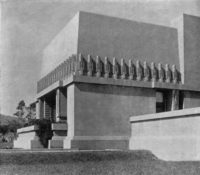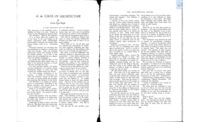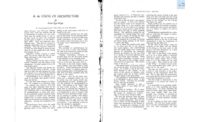The sins of the Architect are permanent sins.
To promote good work it is necessary to characterize bad work as bad.
Half-baked, imitative designs- fictitious semblances – pretentiously put forward in the name of a movement or a cause, particularly while novelty is the chief popular standard, endangers the cause, weaken the efficiency of genuine work, for the time being at least; lower the standard of artistic integrity permanently; demoralize all values artistically; until utter prostitution results. This prostitution has resulted in the new work partly, I have now to confess, as a by-product on an intimate, personal touch with the work, hitherto untried in the office of an American architect; and partly, too, perhaps, as one result of an ideal of individuality in architecture, administered in doses too strong, too soon, for architectural babes and sucklings; but chiefly, I believe, owing to almost total lack of any standard of artist integrity among architects, as a class, in this region at least. Of ethics we hard something occasionally, but only in regard to the relation of architects to each other when a client is in question – never in relation to sources of inspiration, the finer material the architect uses in shaping the thing he gives to his client. Ethics that promote integrity in this respect are as yet unformed and the young man in architecture is adrift in the most vitally important of his experiences, he cannot know where he stands in the absence of any well-defined principles on the part of hos confreres or his elders.
If I had a right to project myself in the direction of and organic architecture twenty-one years ago, it entailed the right to my work and, so far as I am able, the right to defend my aim. Also – yet not so clearly – I am bound to do what I can to save the public from untoward effects that follow in the wake of my own break with traditions. I deliberately chose to break with traditions in order to be more true to Tradition than current conventions and ideals in architecture would permit. The more vital course is usually the rougher one and lies through conventions oftentimes settled into laws that must be broken, with consequent liberation of other forces that cannot stand freedom. So a break of this nature is a thing dangerous, nevertheless indispensable, to society. Society recognizes the danger and makes the break usually fatal to the man who makes it. It should not be made without reckoning the danger and sacrifice, without ability to stand severe punishment, nor without sincere faith that the end will justify the means; nor do believe it can be effectively made without all these. But who can reckon with the folly bred by temporal success in a country that has as yet no artistic standards, no other god so potent at that same Success? For every thousand men nature enables to stand adversity, she, perhaps, makes one man capable of surviving success. An unenlightened public is at its mercy always – the “success” of the one thousand as well as of the one in a thousand; were it not for the resistance of honest enmity. Society, nature herself even, would soon cycle madly to disaster. So reaction is essential to progress, and enemies as valuable an asset in any forward movement as friends, provided only they be honest; if intelligent as well as honest, they are invaluable. Some time ago this work reached the stage where it sorely needed honest enemies if it was to survive. It has had some honest enemies whose honest fears were expressed in the prophetic letters I have mentioned.
But the enemies of this work, with an exception or two, have not served it well. They have been either unintelligent or careless of the gist of the whole matter. It fact, its avowed enemies have generally been of the same superficial, time serving spirit as many of its present load of disciples and neophytes. Nowhere even now, save in Europe, with some few notable exceptions in this country, has the organic character of the work been fairly recognized and valued – the character that is perhaps the only feature of lasting vital consequence.
As for its peculiarities – if my own share in this work has a distinguished trait, it has individuality undefiled. It has gone forward unswerving from the beginning, unchanging, yet developing, in this quality of individuality, and stands, as it has stood for nineteen years at least, an individual entity, clearly defined. Such as it is, its “individuality” is as irrevocably mine as the work of any painter, sculptor or poet who ever lived was irremovably his. The form of a work that has this quality of individuality is never the product of a composite. An artist knows this; but the general public, near-artist and perhaps “critic,” too, may have to be reminded or informed. To grant a work this quality is to absolve it without further argument from anything like composite origin, and to fix its limitations.
There are enough types and forms in my work to characterize the work of an architect, but certainly not enough to characterize an architecture. Nothing to my mind could be worse imposition than to have some individual, even temporarily, deliberately fix the outward forms of his concept of beauty upon the future of a free people or even of a growing city. A tentative, advantageous forecast of probable future utilitarian development goes far enough in this direction. Any individual willing to undertake more would thereby only prove his unfitness for the task, assuming the task possible or desirable. A socialist might shut out the sunlight from a free and developing people with his own shadow, in this way. An artist is too true an individualist to suffer such an imposition, much less perpetrate it; his problems are quite other. The manner of any work (and all work of any quality has its manner) may be for the time being a strength, but finally it is a weakness; and as the returns come in, it seems as though not only the manner of this work or its “clothes” but also its strength in this very quality of individuality, which is a matter of its soul as well as of its forms, would soon prove its undoing, to be worn to shreds and tatters by foolish, conscienceless imitation. As for the vial principle of the work – the quality of an organic architecture – that has been lost to sight, even by public. But I still believe as firmly as ever that without artist integrity and this consequent individuality manifesting itself in multifarious forms, there can be no great civilization, no worthy life. Is, then, the very strength of such a work as this is its weakness? Is it so because of a false democratic system naturally inimical to art? Or is it so because the commercialization of art leaves no noble standards? Is it because architects have less personal honor than sculptors, painters or poets? Or is it because fine buildings are less important now than fine pictures and good looks?
In any case, judging from what is exploited as such, most of what is beginning to be called the “New School of the Middle West” is not only far from the ideal of an organic architecture, but getting farther away from it every day.
A study of similar situations in the past will show that any departure from beaten paths must stand and grow inorganic character or soon fall, leaving permanent waste and desolation in final ruin; it dare not trade long on mere forms, no matter how inevitable they seem. Trading in the letter has cursed art for centuries past, but in architecture it has usually been rather an impersonal letter of those decently cold in their graves for some time.
One may submit to the flattery of imitation or to caricature personally; everyone who marches or strays from beaten paths must submit to one or to both, but never will one submit tamely to caricature of that which one loves. Personally, I, too am heartily sick of being commercialized and traded in and upon; but most of all I dread to see the types I have worked with so long and patiently drifting toward speculative builders, cheapened or be fooled by senseless changes, robbed of quality and distinction, dead forms or grinning originalities for the sake of originality, an endless string of hacked carcasses, to encumber democratic front yards for five decades or more. This, however, is only the personal side of the matter and to be endured in silence were there any profit in it to come to the future architecture of the “melting pot.”







